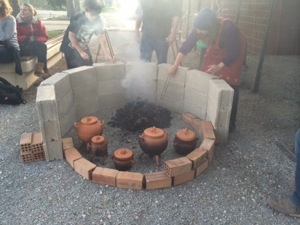Tonight we went to the INSTAP Study Center of East Crete and had a typical Minoan meal from the Bronze Age. Jerolyn Morrison, a researcher at the center, took the time to prepare the meal for us even though she is working on the last chapter of her dissertation. We tried the following dishes prepared with the methods used during the Neopalatial period: rabbit in white wine sauce and juniper berries, lentils with wild garlic leeks and honey, and octopus in beer and cinnamon and juniper.
Researchers, like Jerolyn, are able to identify meals and dishes prepared during the Neopalatial period from chemical residue analysis and macroscopic analysis. Jerolyn prefers to use macroscopic findings to support her research because it involves specific evidence such as animal bones, preserved seeds, and leaf imprints found on mud brick. In addition, researchers also look at frescos and vases to fill in the blanks for food lists.
 Originally trained as a potter, Jerolyn was able to replicate the cooking scene. The clay pots here we’re made in 2009 out of clay from Mochlos. Originally, Jerolyn had used other clay but the pots cracked and didn’t last as long. Instead, she used the type of clay the Minoans used at the time and it has proven to be durable.
Originally trained as a potter, Jerolyn was able to replicate the cooking scene. The clay pots here we’re made in 2009 out of clay from Mochlos. Originally, Jerolyn had used other clay but the pots cracked and didn’t last as long. Instead, she used the type of clay the Minoans used at the time and it has proven to be durable.

The basic Minoan cooking pot is a tripod shape, with three legs supporting the bowl. The reason why they made their pots in that style was because the vessels elevated the pot so that way they could have a portable hearth.
Overall the meal was wonderful! And I found it interesting how cooking can help us understand ourselves as people and the evolution of our identities through by looking back and then recreating our interpretation of the past.
